FREE EIAT Mechanical Aptitude Questions and Answers
In which direction will the swings tilt?
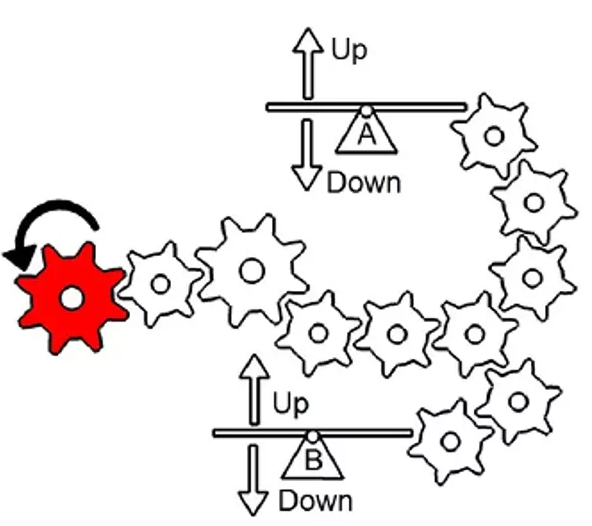
Explanation:
In order to determine in which direction the swings tilt, we will need to determine the rotation direction of each gear that comes in contact with the swing. They are marked in the picture below as gears A and B.
Counting the gears from the red gear to gear A, we see there are 8 gears. Therefore, the red gear and gear A rotate in the same direction – counterclockwise. That rotation will cause the right arm of swing A to tilt downwards (blue arrow), and therefore the opposite side will tilt upwards.
In the same manner, there are 7 gears between the red gear and gear B, and therefore it will rotate in the opposite direction – clockwise. That will tilt the right arm of the swing upwards, causing the left side to tilt downwards.
Which cyclist has to pedal harder in order to go up the ramp?

Explanation:
In this question, we are asked which rider would need to pedal harder in order to climb the ramp.
We can see that though the ramps are of different lengths, the height of the logs in both cases is the same. For this reason, we should understand that the shorter ramp will be steeper. As is known from daily life, it is harder to pedal up a steeper incline.
Since in Figure B, the length is shorter and the incline is greater, it would be harder to pedal up the ramp.
Which tractor has to drive farther in order to bring the boat to shore?
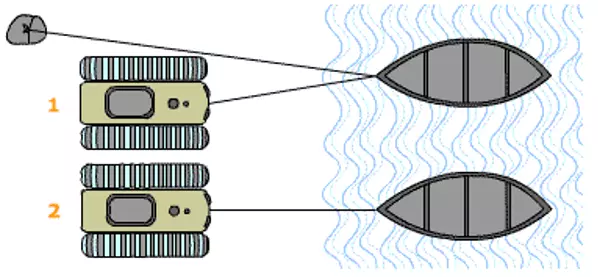
Explanation:
Tractor 2 will drive in a straight horizontal heading, in the same direction as the boat is from the shore. This is the shortest line possible.
Tractor 1 will also drive in a horizontal line, but as it is tied to the boat diagonally it will therefore pull the boat over a larger distance. However, tractor 1 will have to apply less force due to the mechanical help from the rock (the same as in a movable pulley).
Which way will the bottom cogwheel rotate?
(If the information is insufficient, mark C.)
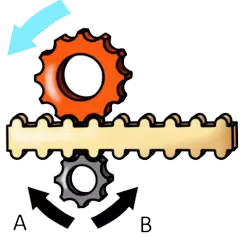
Explanation:
When contact is made between the rack (toothed belt) and the cogwheels, a conversion from a linear velocity to an angular velocity occurs. The location of the point of contact is critical.
The point of contact between the red cogwheel and the rack is in the lower part of the red cogwheel. The counterclockwise angular velocity induces a linear velocity to the right.
The point of contact between the grey cogwheel and the rack is in the grey cogwheel's upper part. The linear velocity to the right (determined by the rack) induces an angular velocity in a clockwise direction.
Remember the physical principle: When converting the linear velocity of a rack to the angular velocity, “translate” the rotation into arrows and follow the directions.
If the middle gear is rotating clockwise, which gear, A or B, will rotate in the same direction?
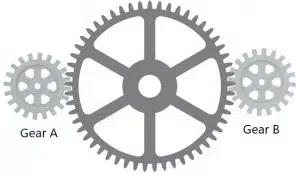
Explanation:
It can be observed from the image that gears A and B are linked directly to the middle gear. However, when two gears are directly linked, their tangential velocities are always the same, although the directions of their rotation are always opposite to each other.
In our case, the velocity vector between the middle gear and gear A will point upwards and the direction of rotation of the middle gear and gear A will be clockwise and counterclockwise respectively. Similarly, the velocity vector between the middle gear G and gear B will point downwards and the rotation of gear B will be counterclockwise. Hence both gears A and B will rotate in the opposite direction of the middle gear.
Similar balls are thrown into containers A and B. The ball sinks in container A and floats in container B. Which container is filled with denser liquid?
(If the information is insufficient, mark C.)
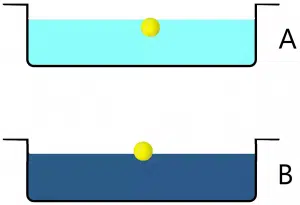
Explanation:
When an object is immersed in liquid, a pressure difference is created between its opposite sides. This pressure difference causes a force that pushes the object upwards, known as buoyancy. It is defined as:
Buoyant Force B = density of liquid (ρ) × displaced volume of fluid (V) × gravitational acceleration(g)
Elevator Aptitude Test sample
This shows that the denser the liquid, the greater the buoyant force, and the object will be more likely to float. In our case, the liquid in container B must be denser for the same ball to float higher. Forces acting on the ball are shown in the figure.
In which case is a stronger force required to lift the load?
(If equal, mark C.)

Explanation:
In the given scenario, the weight is supported by two different mechanisms. In case A, the weight is being lifted with the help of four pulleys joined by a single string, while four parts of the string lift the load. The tension force in the string will be equally divided between the parts of the string. Hence the total effort required to lift the load “W’ will be “W/4.”
In case B, there are two strings, each connected to two pulleys and having two pieces each. The load, in this case, will be divided into two since two strings are being used. First, analyze the left string. The load to be lifted is W/2. The tension in each piece of the string will be half the load, i.e. W/4. The tension in the right string will also be the same. Since two people are pulling in case B, each will require an effort of W/4 and the total effort will be W/2. Hence Case B will require a stronger force in lifting the load.
Advertisement
Which of the two illustrated scenarios is physically possible?
(If both or neither, mark C.)

Explanation:
The given scenario shows a class 1 lever balanced in two different cases. We assume load on the right side of the fulcrum and effort on the left. Now, in case A, load and effort are equal and so are the moment arms of both load and effort. This means that the moments of both the load and effort cancel out each other and as a result, the lever is balanced. Hence, case A is very likely to be possible.
In case B, the effort is greater than the load, but the moment arm of effort is smaller than the moment arm of the load. The resultant moment, in this case, will also be zero since the moment is the product of force and moment arm and one factor compensates for the other in this case. Therefore this case is also physically possible.
Therefore, both scenarios are physically possible.
What are the direction and the velocity of rotation (angular velocity) of Gear 3 compared to Gear 1?
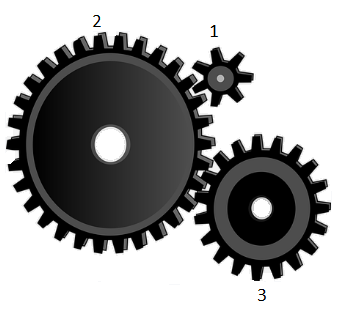
Explanation:
The correct answer is Gear 3 rotates slower than Gear 1 and both rotate in the same direction.
Which wheels are turning counter-clockwise?

Explanation:
Wheels A, B, D, and F are turning counterclockwise. The wheels in contact with the wire will turn depending on which direction around the wheel the wire goes. Follow the wire as it passes around all the wheels. Try to mentally turn the wheels while following the direction of the wire.
A spring bearing a 10-pound weight has stretched 0.5 inches. If you were to increase the weight to 15 pounds, how many inches would the spring stretch?

Explanation:
We know that the spring stretches 0.5 inches under a pull of 10 pounds. We also know that springs behave linearly. Therefore, adding another 5 pounds, which is half of the 10-pound pull, the spring will stretch another 0.25 inches, which is half the distance it stretched under a pull of 10 pounds. Simply add: 0.5 + 0.25 = 0.75. So the spring would stretch 0.75 inches.